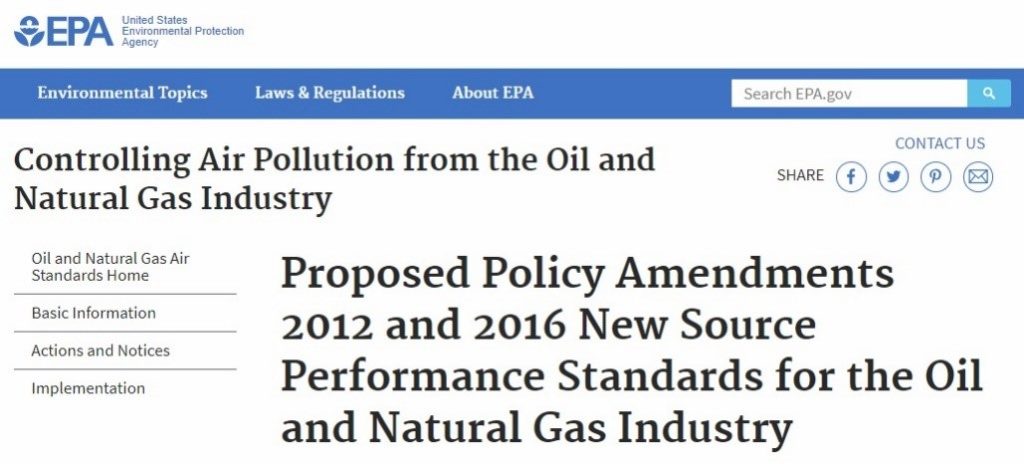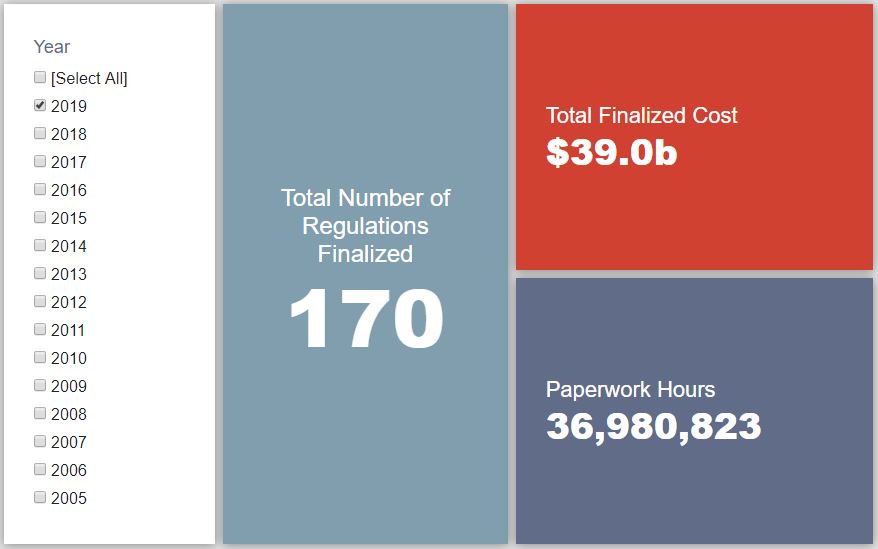Week in Regulation
September 3, 2019
August Wraps Up on a Quiet Note
Between the ongoing congressional recess and people heading out of town to enjoy the unofficial end of summer, the week preceding Labor Day can typically be a quiet one around Washington, DC. Regulatory activity during the past week followed that trend. There were seven rulemakings with some quantified cost or savings estimate, but none crossed the $100 million mark on either side of the ledger. Across all proposed and final rules, agencies published $30.8 million in total net costs and added 244,167 hours of annual paperwork.
REGULATORY TOPLINES
- New Proposed Rules: 38
- New Final Rules: 64
- 2019 Total Pages: 45,790
- 2019 Final Rule Costs: $39 Billion
- 2019 Proposed Rule Costs: -$5.2 Billion
TRACKING THE REGULATORY BUDGET
The most costly rulemaking of the week was a proposed rule from the Department of Health & Human Services (HHS) regarding “Confidentiality of Substance Use Disorder Patient Records.” The proposal seeks to update certain health privacy standards in the face of the opioid crisis. HHS, however, estimates that this update could mean roughly $99.5 million in new costs due to increased disclosure and reporting requirements.
The largest savings of the of the week come from a proposed rule out of the Environmental Protection Agency (EPA), entitled “Tolerance Crop Grouping Program V.” EPA seeks to revise “its pesticide tolerance crop grouping regulations, which allow the establishment of tolerances for multiple related crops based on data from a representative set of crops.” The agency estimates that this rule could save affected herb and spice growers roughly $55.1 million in savings each year.
Neither of these aforementioned rules affect the fiscal year (FY) 2019 regulatory budget under Executive Order (EO) 13,771, as they are still in the proposed stage. There were, however, a couple of final rules that contributed – albeit minimally – toward the budget. One involves the Department of the Army updating its procedures regarding its cemeteries. The other, out of the Department of Transportation, extends a previous stay of a 2016 railway safety measure. The grand total of savings from this pair of rules adds up to roughly $200,000.
So far in FY 2019 (which began on October 1, 2018), there have been 60 deregulatory actions (per the rubric created by EO 13,771 and the administration’s subsequent guidance document) against 34 rules that increase costs and fall under the EO’s reach. Combined, these actions yield quantified total net costs of roughly $11.8 billion. This total, however, includes the caveat regarding the baseline in the Department of Agriculture’s “National Bioengineered Food Disclosure Standard.” If one considers that rule to be deregulatory, the administration-wide net total is approximately $5.1 billion in net costs. The administration’s cumulative savings goal for FY 2019 is approximately $18 billion. There is now less than a month left in the fiscal year.
THIS WEEK’S REGULATORY PICTURE
This week, the Environmental Protection Agency (EPA) proposes to deregulate methane emissions from the oil and natural gas industry.

The EPA announced a proposed rule this week that would scale back Obama-era rules on methane in the oil and natural gas industry. The proposed rule would reinterpret rules that placed methane-specific monitoring requirements on storage and transmissions systems (essentially tanks and pipelines). Instead, the rule will require monitoring of broader “volatile organic compounds,” which includes methane.
While EPA acknowledges the proposal will prevent fewer methane emissions than the rule it would replace, the agency believes the forgone benefits are more than outweighed by cost savings. EPA estimates the rule will save $97 million in costs between 2019 and 2025 while forgoing $13 million in benefits over the same period.
Unlike most of the recent deregulatory actions proposed by the EPA, the oil and natural gas industry is split over whether the regulatory relief is worth it. Large oil companies, such as ExxonMobil, have asked EPA to maintain the Obama-era rules, which they believe will bolster the reputation of natural gas as a viable energy source that reduces greenhouse gas emissions. Others, including independent companies, believe the precedent EPA set with its previous rule will likely require future regulation of smaller operations that threaten their ability to compete with larger companies.
Like most of the recent deregulatory actions proposed by the EPA, many environmental proponents disagree with the proposal, arguing it would intensify climate change because methane is an extremely potent greenhouse gas. Already, calls for a lawsuit and a Congressional Review Act resolution to nullify the rule have emerged, despite that neither could take place until the rule is finalized – which could happen sometime in 2020.
TOTAL BURDENS
Since January 1, the federal government has published $33.8 billion in total net costs (with $39 billion in finalized costs) and 42.7 million hours of net annual paperwork burden increases (with 37 million coming from final rules). Click here for the latest Reg Rodeo findings.












